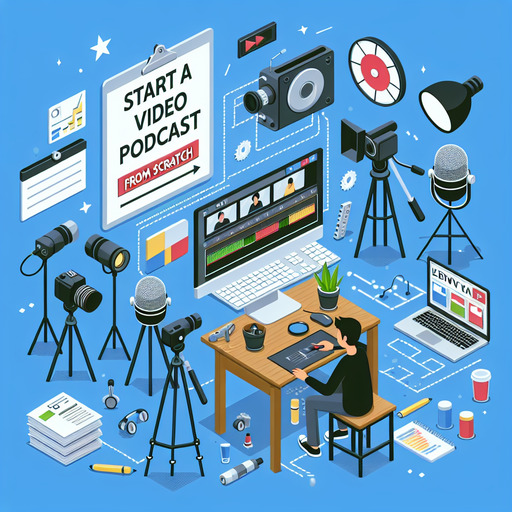
-
Table of Contents
Ready to launch your video podcast? Discover the step-by-step guide to starting from scratch and make your voice heard! Learn more here.
Introduction
Starting a video podcast from scratch involves several key steps, from planning and equipment selection to recording and distribution. First, define your podcast’s niche and target audience to ensure your content is focused and engaging. Next, invest in essential equipment such as a good quality camera, microphone, and lighting to ensure professional-looking and sounding episodes. Choose a suitable recording space that minimizes background noise and distractions. Plan your content and format, including episode length, structure, and frequency. Record your episodes, paying attention to both audio and video quality. Edit your recordings using video editing software to enhance the final product. Finally, select a hosting platform to upload your episodes and distribute them to various podcast directories and social media channels to reach your audience. Consistency and quality are key to building and maintaining a successful video podcast.
How to Start a Video Podcast from Scratch: Essential Tips and Equipment for Successful Video Podcasting
Starting a video podcast from scratch can seem daunting, but with the right approach and equipment, you can create a successful and engaging show. The first step in this journey is to clearly define your podcast’s niche and target audience. Understanding who you are speaking to and what topics will resonate with them is crucial. This will not only guide your content creation but also help in marketing your podcast effectively.
Once you have a clear vision, the next step is to plan your content. Outline your episodes, decide on the format, and create a content calendar. Consistency is key in podcasting, so having a well-thought-out plan will keep you on track and ensure that you deliver regular, high-quality episodes. Additionally, consider the length of your episodes. While some audiences prefer short, bite-sized content, others may enjoy longer, in-depth discussions. Tailor your episode length to your audience’s preferences.
With your content plan in place, it’s time to focus on the technical aspects. The quality of your video and audio can significantly impact your podcast’s success. Investing in a good camera is essential. While you don’t need the most expensive equipment, a camera that can record in at least 1080p HD will provide a clear and professional look. Additionally, good lighting is crucial. Natural light is great, but if you’re recording indoors, consider investing in softbox lights or ring lights to ensure your video is well-lit and visually appealing.
Audio quality is equally important. A high-quality microphone will make a significant difference in how your podcast sounds. USB microphones are a good starting point for beginners, as they are easy to use and provide excellent sound quality. If you have a larger budget, consider an XLR microphone with an audio interface for even better audio fidelity. Don’t forget to use pop filters and shock mounts to minimize unwanted noise and vibrations.
Next, you’ll need to choose the right software for recording and editing your podcast. There are several options available, ranging from free to premium. For video recording, software like OBS Studio or Ecamm Live can be very effective. For editing, Adobe Premiere Pro and Final Cut Pro are popular choices among podcasters, but if you’re looking for a free option, DaVinci Resolve is also highly recommended. When editing, focus on creating a smooth and engaging flow, removing any unnecessary pauses or mistakes, and adding any graphics or effects that enhance the viewer’s experience.
Once your episode is ready, it’s time to publish and promote it. Choose a reliable podcast hosting platform that supports video content, such as YouTube, Vimeo, or specialized podcast hosting services like Podbean or Libsyn. These platforms will help you distribute your podcast to various directories and reach a wider audience. Additionally, create social media profiles for your podcast and actively engage with your audience. Share behind-the-scenes content, teasers, and interact with your listeners to build a loyal community.
In conclusion, starting a video podcast from scratch involves careful planning, investing in the right equipment, and consistently delivering high-quality content. By understanding your audience, creating a solid content plan, and focusing on both video and audio quality, you can set the foundation for a successful video podcast. With dedication and persistence, your podcast can grow and thrive, reaching and engaging viewers around the world.
Q&A
1. **Question:** What are the essential steps to start a video podcast from scratch?
**Answer:**
– **Define Your Concept:** Choose a niche, target audience, and format.
– **Plan Your Content:** Outline episodes, create a content calendar, and prepare scripts or talking points.
– **Gather Equipment:** Invest in a good camera, microphone, lighting, and editing software.
– **Set Up Recording Space:** Ensure good acoustics, proper lighting, and a clean background.
– **Record Your Episodes:** Test equipment, ensure good audio and video quality, and record your content.
– **Edit Your Videos:** Use video editing software to cut, add effects, and polish your episodes.
– **Create Branding:** Design a logo, intro/outro, and thumbnails.
– **Choose a Hosting Platform:** Select a platform to host your video podcast (e.g., YouTube, Vimeo).
– **Publish and Promote:** Upload your episodes, optimize for SEO, and promote on social media and other channels.
– **Engage with Your Audience:** Respond to comments, gather feedback, and build a community.